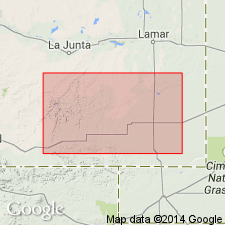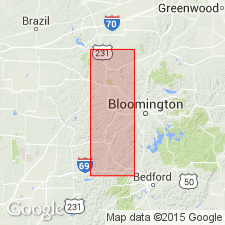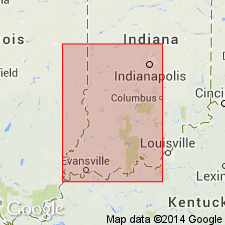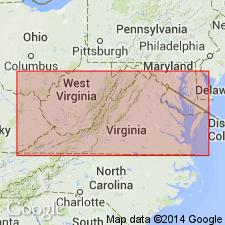
- Usage in publication:
-
- Ste. Genevieve limestone*
- Modifications:
-
- Areal extent
- AAPG geologic province:
-
- Anadarko basin
Summary:
Extended into the subsurface of Baca County, Colorado, in the Anadarko basin, east of the Las Animas arch. Consists of cream-colored, finely-sandy and oolitic limestone that has fragments of reworked orange-stained chert. Is 200 feet thick. Overlies St. Louis limestone and underlies unnamed Morrowan rocks. Age is Late Mississippian (Meramecian). Report includes correlation chart.
Source: Modified from GNU records (USGS DDS-6; Denver GNULEX).

- Usage in publication:
-
- Ste. Genevieve Formation
- Modifications:
-
- Revised
- AAPG geologic province:
-
- Illinois basin
Summary:
Indian Creek Limestone Beds are introduced here as a new name for the lower half of the Levias Member of the Ste. Genevieve Formation in Lawrence and Monroe Cos., south-central IN. Unit is composed of lithographic, silty, thinly and evenly bedded limestone. Top is 28 ft below the Bryantsville Breccia Bed. Beds are 27.5 ft thick and conformably overlie the Rosiclare Member. Ste. Genevieve is a formation within the Blue River Group in IN. Overlies the St. Louis Formation and underlies the Aux Vases Formation, both of Blue River. Age is Valmeyeran.
Source: GNU records (USGS DDS-6; Reston GNULEX).

- Usage in publication:
-
- Ste. Genevieve Limestone
- Modifications:
-
- Revised
- AAPG geologic province:
-
- Illinois basin
Summary:
Usage of the Ste. Genevieve Limestone of the Blue River Group in Indiana is here revised. In the subsurface, unit is divided into (ascending) Fredonia, Karnak, and Joppa Members, which are basically equivalent to members of the same name in IL. Levias and Spar Mountain Members of Ste. Genevieve are no longer used in Indiana. This nomenclature replaces that of Shaver and others (1986) as the IN State usage. In outcrop, Joppa is replaced by rocks typical of upper Karnak. Uppermost rocks of the Ste. Genevieve on the surface and in the very shallow subsurface are assigned to the Bryantsville Breccia Bed of the Karnak Member. Bryantsville of previous usage marked the top of the Levias Member. Lost River Chert Bed marks the base of the Fredonia Member and therefore the base of the Ste. Genevieve. Fredonia is stratigraphically extended in this study to include the equivalent to both the Fredonia and Spar Mountain Members as previously used on the outcrop in Indiana. Ste. Genevieve overlies the St. Louis Limestone and underlies the Paoli Limestone (revised), both of Blue River Group. Age is Valmeyeran [Meramecian].
Source: GNU records (USGS DDS-6; Reston GNULEX).

- Usage in publication:
-
- "St. [Ste.] Genevieve" Limestone Member
- Modifications:
-
- Revised
- AAPG geologic province:
-
- Appalachian basin
Summary:
In this report, Greenbrier Limestone divided into (ascending) Little Valley Limestone Member, St. Louis Limestone Member (Hillsdale Member of Reger, 1926), the "St. Genevieve" Limestone Member, and the Gasper Limestone Member. According to author, the upper middle part of the Greenbrier is equivalent to the "St. Genevieve." In the subsurface and surface exposures, the unit consists principally of gray, oolitic limestone. Base is marked by the presence of the Taggard red of Reger (1926). Taggard red beds are composed of three beds: a lower and upper shale with an intervening limestone. These beds in VA are composed of grayish-red and greenish-gray limestone and calcareous shale. Beds range in thickness from 3 to 50 ft and normally lie about 50 ft above the base of the Greenbrier. The most characteristic fossil is the index fossil PLATYCRINUS HUNTSVILLAE Troost. Other diagnostic forms present are CYSTELASMA QUINQUESEPTATUM Ulrich, PRODUCTUS (DICTYOLASTUS) PARVUS Meek and Worthen, and PUSTULA GENEVIEVENSIS (Weller). Age is Late Mississippian (Meramecian).
Source: GNU records (USGS DDS-6; Reston GNULEX).

- Usage in publication:
-
- Ste. Genevieve Limestone*
- Modifications:
-
- Overview
- AAPG geologic province:
-
- Illinois basin
Summary:
Used as Mississippian (Valmeyeran) Ste. Genevieve Limestone of Blue River Group in IN. Usage follows Droste and Carpenter (1990).
Source: GNU records (USGS DDS-6; Reston GNULEX).
For more information, please contact Nancy Stamm, Geologic Names Committee Secretary.
Asterisk (*) indicates published by U.S. Geological Survey authors.
"No current usage" (†) implies that a name has been abandoned or has fallen into disuse. Former usage and, if known, replacement name given in parentheses ( ).
Slash (/) indicates name conflicts with nomenclatural guidelines (CSN, 1933; ACSN, 1961, 1970; NACSN, 1983, 2005, 2021). May be explained within brackets ([ ]).

